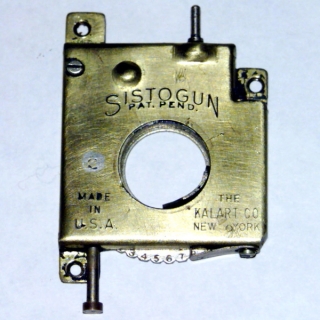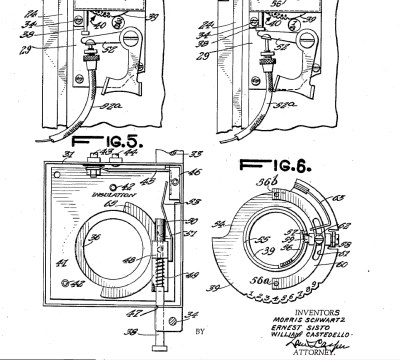

Thanks to Ernest Sisto Jr. who told me that his father
invented the Sisto Gun.
As a young boy he loved to join his father to the newspaper.
Mr. Ernest Sisto who was staff photographer of the New York times, invented a device which made it possible to synchronize the Anniversary Speed Graphic focal plane shutter with a flash-gun. The Anniversary equipped with a focal plane shutter needs to be wind up to a certain speed and when releasing the shutter, the slit of the curtain travels along the film surface. During that time a bulb should produce its peak-light long enough to expose the 4 inches of film surface that the slit needs to travel along . The device mounted under the winding knob makes use of the movement of the winding key when the shutter is fired. With Sisto-Gun camera men synchronized their Speed Graphic without loss of shutter speed, even at 1/1000 second. The Sisto-Gun could be used with the battery cases of most popular flash synchronizers.


Left photo the Sisto gun and on the right photo portion of the US Patent 2.291.190 by Morris Schwartz, William Castedello and Ernest Sisto.
Article published in the Brooklyn Eagle Saturday Jan. 10. 1942.
A reader writes:
"I have a 3 1/4 x 4 1/2 Anniversary Model Speed Graphic
and in the past have been very unsuccessful taking synchronized flash pictures
at 1/1000th second with the focal plane shutter.
I'm using super XX cut
film and Wabash 40.000 press flash bulbs.
What is wrong?"
Your first mistake is your choice of flash bulb.
When using
your focal plane shutter to obtain a speed of 1/1000th second it is generally
recommended to use the wire filled slow burning Wabash no. 2-A bulb,
whose flash
is much longer than the one you are using with your focal plane shutter.
Light
is admitted to the film through a slit in the curtain moving down and only a portion of the picture is exposed during this operation.
With your front
Compur shutter the entire picture is exposed at once, as the light enters
the camera through the center equally over the entire film.
Next I would advice
you to change your film when shooting at high speeds,
so that you may reduce
your diaphragm opening and increase your depth of field to insure sharp crisp
negatives.
Try using either Tri-X cut film or Super Pan Press.
Both films have
the same speed ratings and characteristics.
Your most serious error is in method of synchronizing your
shutter and flash bulb.
Only synchronizer that will actually synchronize these
two is a gun that had just been perfected by Ernest Sisto,
a New York newspaper
staff photographer working in co-operation with the engineers of the Kalart Company.
The Sisto-Gun, when properly installed on your camera allows you to get
those photographs that only can be obtained at 1/1000th second.
This little
device is installed over the winding key of the back shutter of your speed
Graphic and in no way interferes with its smooth operation.
A pair of brass pins
electrically connects it to your present battery case.
There is also an
adjustment lever to insure complete exposure and perfect synchronization.
I have
nothing but praise for this very efficient device and sincerely recommend it
highly.
The Wabash long peak was very popular with the flashing 4x5 Focal Plane sport photographers.
Note from the web site publisher.
The above conclusion is correct as far as it concerns the
Speed Anniversary camera.
The Anniversary Speed Graphic is the predecessor
of the Pacemaker Speed Graphic and was not equipped with a build in flash
synchronizer.
The Pacemaker Speed Graphic however,
has build-in metal contacts in the focal plane curtain, synchronized for each
slit to fire the flash just in time,
including the necessary time delay
for the bulb to "peak".
This improvement made an accessory such as the
Sisto gun, redundant.
However the writer of the article above is
right about the choice of the bulb for use
with the 4x5 Focal Plane shutter: Wabash
2 A bulb
The duration of the long peak of this bulb enables the exposure of
the 4 inches of film and the time that the slit takes to travel along that
length of film
surface.
Please take in mind that a 4x5 inch focal plane shutter needs more time
to travel along the film surface than on a 3 1/4 x 4 1/2 camera.

Ernest Sisto a New York Newspaper staff photographer invented the Sisto Gun for easy synchronizing at
1/1000th second with the focal plane shutter.
Ernest Sisto used everything from a 35-millimeter camera to The
Times' ''Big
Bertha,'' sometimes carrying 100 pounds of equipment to get a picture.
He flew over Hudson Bay to bring back exclusive shots of the 1954 solar
eclipse.
He worked at every national political convention of both parties
from 1928 to 1948 and at more World Series than he cared to count.
A
perfectionist, he straddled a cable to shoot a bird's-eye view of the 363-foot
Bronx-Whitestone Bridge, hung out with legs held down by two newsmen over a
parapet 86 stories
above the street and took the historic photo of the
crash of a B 25 bomber that crashed into the Empire State Building in July 1945.
The photo below ran at page one of the New York Times.


As much as 5 Ernest Sisto photos were
published in the New York Times book of the Museum of Modern Art, New York
"A Century of Photography from The New York Times"